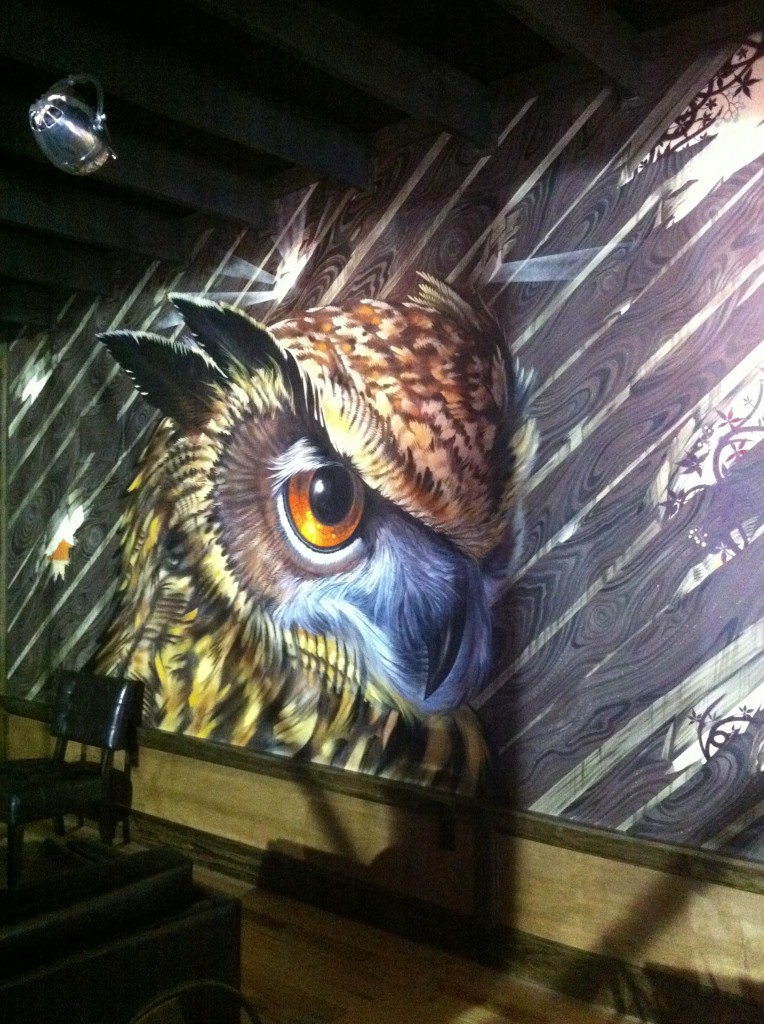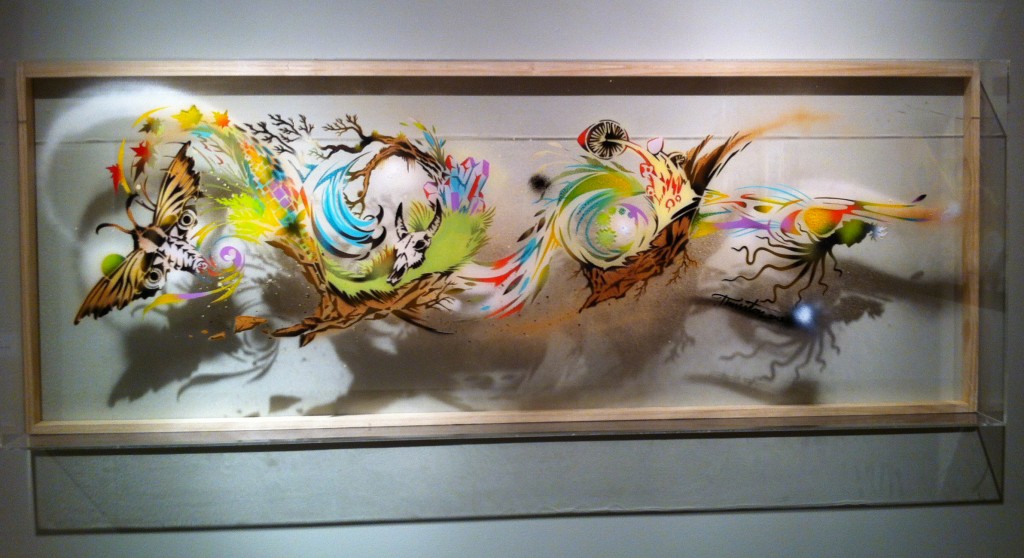 A great thing about Atlanta is that new stuff is always popping up—new bars, new restaurants, new events. And it was during a recent visit to check out the new East Atlanta Village spot The Argosy that something else new caught our eye: a large owl mural covering their back wall. It perfectly complimented Argosy’s Twin Peaks-esque vibe, and we were intrigued.
A great thing about Atlanta is that new stuff is always popping up—new bars, new restaurants, new events. And it was during a recent visit to check out the new East Atlanta Village spot The Argosy that something else new caught our eye: a large owl mural covering their back wall. It perfectly complimented Argosy’s Twin Peaks-esque vibe, and we were intrigued.
That’s how we found out about artist Shaun Thurston. An Old Fourth Ward Atlanta dweller for years before he returned to his hometown of Jacksonville, Fl., painting is Thurston’s full-time gig, and one that brings him back to the ATL often, luckily.
CommonCreativ chatted with Thurston about self-promotion, his favorite creatives around town and his spirit animal.
CommonCreativ: How did you end up in Atlanta?
Shaun Thurston: I had always heard of the history and culture coming from Atlanta, but hadn’t visited there until I finished high school. I’ve lived in a couple other towns so I moved to Atlanta in 2007 knowing that it was temporary. I was a tourist who took notes in a sketchbook, and I ran around with code-named friends painting in secret spots and got one last bit of mischief out of my system. I love and miss ATL all the time, and when you see me there, it’s usually because I’m working and reconnecting with friends.
CC: What sparked your interest in painting?
ST: I’ve drawn from my imagination and done little life studies for as long as I can remember. Slowly, it became one of the things that never lost my interest, and it felt like the genuine purpose of my existence until my daughter was born. I wrapped up so much of my ego in the idea of being an artist that wouldn’t settle for mediocre anything when it came to a technique. But the immediate inspiration I found in the first couple of brush strokes in a painting is what had me hooked. Painting has always centered me. If I’m in a bookstore, museum, zoo, wilderness, broken-down building or just alone with my thoughts, I will sometimes have an intense wave of motivation to get my ideas down in some form of permanence. I don’t have the best memory, so drawing has always aided my understanding and helps me remember things.
CC: Is art your full-time gig?
ST: Being creative is my only source of income. I get paid more to paint, design and draw than anything else I can do, and it’s the most rewarding work I’ve found. In the past, I would get an uncomfortable job when money got tight and work wasn’t steady, and I picked up a lot of skills from each place I clocked in. Fortunately, for the last four years, I’ve had pretty steady work, and having another job gets in the way of being able to do large projects that need me to be out of town for weeks or a month at a time.
ST: Artwork that really inspires me doesn’t look anything like what I paint. I’m a painter who wants my paintings to look like they are made by hand and not trying to look photographic. I try to think about everything the piece could be, and the second an idea really resonates with me, I start working. The wall that holds the paint is only a small part of the environment that is being effected, and I want the total space to inspire me to create something within it. Channeling my own reaction to the space is usually the first step in a working process. I use it as a way to understand more about my relation, and therefore everyone’s relation, to the subject material of each piece.
 CC: There’s a lot of animal imagery in your pieces.
CC: There’s a lot of animal imagery in your pieces.
ST: Animals are my first love and were my key to making any sense of this world. Growing up in Florida means that you are always interacting with wild animals that have a very real ability to harm and kill you. Communicating with an animal is a transformative experience, and I try to recreate that feeling with my animal murals. Our relation to them is among the most important issues concerning equilibrium with the planet. Because animals have been used in artwork from the very first marks made in a cave, it’s classic subject matter that we are all emotionally linked to and helps us to understand our true nature.
CC: What’s your spirit animal? (This question is only half-serious.)
ST: There have been two separate occasions when Native American men walked below me while I was painting a mural on a ladder, and they both called me “the crow.” When they asked me my birthday, my answer made both men say in different ways, “Yes, definitely the crow.” The second time I thought I was being scammed or there was some kind of handbook on how to mystify a white boy into giving you his attention, but neither of them wanted anything other than to tell me that I was a crow, give me a little info on what that means and to keep up the good work.
CC: As an independent artist, how do you promote yourself?
ST: A strong portfolio is the best resume. I respond to emails about interest in my work, but I know I’m this obscure painter living in Jacksonville, and I might remain so unless I’m more proactive about promoting myself. Graffiti was the only pure self-promotion I engaged in that felt honest even though it was criminal. I want to be successful in the studio before I try to be successful in the world. The whole reason I’m an independent artist is because I want to live in a way that feels natural to me, and self-promotion has never felt that way. When I was listening to people telling me to brand myself and promote my work, I was miserable and my work suffered. Word of mouth, a strong portfolio and an ability to follow through on a paid commission are all that I’ve ever needed to get by. Selling work from my studio helps as well.
CC: We love your mural inside East Atlanta’s The Argosy. How did that come about?
ST: I met Ben Rhoades [owner of MJQ and Bookhouse Pub] in Miami during Art Basel where I was painting a wall. Dosa Kim who is one of my best friends, introduced me to him with the words, “This is the guy you need for your new space.” We had some drinks, Dosa and my girlfriend almost cried together talking about the Fireflies on the Water installation at the Whitney [in New York], and Ben and I looked at pictures of Argosy in a very raw state. Ben called me six months later to come check out the space, and after a weekend of brainstorming, I was up there in a month with sketches to start work on the first of the three walls I painted for them.
 CC: Where else can people see your work?
CC: Where else can people see your work?
ST: In Atlanta, I painted the inside of Martin Luther King Jr. Middle School’s gym with a giant cobra, which is their mascot. I’ve got another mural at the Oakhurst Community Garden that was done for the first Living Walls conference. The fox and dragon wall outside of The Argosy is pretty visible. I saw that the wall I painted with Isto behind WonderRoot is still intact. I still see some of the street spots that I scribbled on haven’t been covered, so there’s a little evidence that I once lived there.
CC: Who are some of your favorite Atlanta creatives?
ST: Ryan Coleman, who has moved back to ATL after a decade or more in New York, as always is painting really exciting, beautiful work. BORN is one of the greatest innovators the South has ever produced. There’s also Joy Phrasavath who happens to paint, but he’s an artist in every way. Ronnie Land is from Jacksonville but has been in Atlanta so long that he’s more local to Atlanta—he puts humor in his art and it works. Sarah Emerson just painted the Atrium in the Museum of Contemporary Art in Jacksonville—it’s huge and beautiful. Then there’s the classic Atlanta lineup that really defines ATL neighborhoods in my mind—like Dosa, Michi, Sam Parker, John Tindel, Rene Arregada, Bethany Marchman, Totem, Peter Ferrari. The Paper Twins were always favorites. Never seems busy. Harrison Keyes does cool stuff. I’m a fan of everything Beep Beep Gallery and MINT Gallery did while I was there; Mike Germon has a great aesthetic in his own work; Russ Abbott’s tattoos are killer. I won’t get into the graffiti roster of ATL because if I leave anyone out, then dudes get their feelings hurt—I don’t think they want to be called artists anyway.
CC: What do you think about the Atlanta arts scene?
ST: I think Atlanta’s art scene is excellent. Every time I visit and check out a show, it’s packed. As long as everyone is proud to be a part of it and expecting it to continually evolve, it will perpetually cultivate its own style and identity. Too many people compare one place to another in an attempt to determine what’s better or worse about a scene, but all I want from the scenery is for it to feel authentic. The idea of a scene makes me think of a snapshot in a long sequence of events, and the way to guarantee that each scene is interesting is to keep the variables diverse. Atlanta feels like it has the highest of high art and the lowest of the squat-studio low and everything in between. I hope Atlanta’s art scene becomes a place that continues to create stars within the city and generates interest from everyone, not just the people within the industry.
For more on Shaun Thurston, check out shaunthurston.com and follow @endlesssummoner on Instagram.






